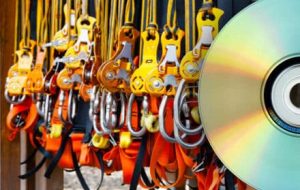Fall Protection
OSHA Training Requirements - Fall Protection
This website is not the official or final authority to determine OSHA compliance responsibilities, which are set forth in OSHA standards themselves, and the Occupational Safety and Health Act of 1970. Because OSHA regulations are constantly being added, deleted, and/or revised, you must not rely on this website as the official or final authority of OSHA training requirements; refer to the official OSHA regulations available on OSHA’s website (osha.gov). – See disclaimers.
1926.500 – 1926.503 – Fall Protection
1926.502 – Fall Protection Systems Criteria and Practices
(c)(4)(ii) When the employer can demonstrate that it is unreasonable to perform the drop-test required by paragraph (c)(4)(i) of this section, the employer (or a designated competent person) shall certify that the net and net installation is in compliance with the provisions of paragraphs (c)(3) and (c)(4)(i) of this section by preparing a certification record prior to the net being used as a fall protection system. The certification record must include an identification of the net and net installation for which the certification record is being prepared; the date that it was determined that the identified net and net installation were in compliance with paragraph (c)(3) of this section and the signature of the person making the determination and certification. The most recent certification record for each net and net installation shall be available at the jobsite for inspection.
(d)(15) – Anchorages used for attachment of personal fall arrest equipment shall be independent of any anchorage being used to support or suspend platforms and capable of supporting at least 5,000 pounds (22.2 kN) per employee attached, or shall be designed, installed, and used as follows:
(ii) – under the supervision of a qualified person.
(d)(19) – Personal fall arrest systems and components subjected to impact loading shall be immediately removed from service and shall not be used again for employee protection until inspected and determined by a competent person to be undamaged and suitable for reuse.
(h) – “Safety monitoring systems.” Safety monitoring systems [See 1926.501(b)(10) and 1926.502(k)] and their use shall comply with the following provisions:
(1) – The employer shall designate a competent person to monitor the safety of other employees and the employer shall ensure that the safety monitor complies with the following requirements:
(i) – The safety monitor shall be competent to recognize fall hazards;
(k) – “Fall protection plan.” This option is available only to employees engaged in leading edge work, precast concrete erection work, or residential construction work (See 1926.501(b)(2), (b)(12), and (b)(13)) who can demonstrate that it is infeasible or it creates a greater hazard to use conventional fall protection equipment. The fall protection plan must conform to the following provisions.
(1) – The fall protection plan shall be prepared by a qualified person and developed specifically for the site where the leading edge work, precast concrete work, or residential construction work is being performed and the plan must be maintained up to date.
(2) – Any changes to the fall protection plan shall be approved by a qualified person.
(4) – The implementation of the fall protection plan shall be under the supervision of a competent person.
1926.504 – Training Requirements
The following training provisions supplement and clarify the requirements of 1926.21 regarding the hazards addressed in subpart M of this part.
(a) – “Training Program.”
(1) – The employer shall provide a training program for each employee who might be exposed to fall hazards. The program shall enable each employee to recognize the hazards of falling and shall train each employee in the procedures to be followed in order to minimize these hazards.
(2) – The employer shall assure that each employee has been trained, as necessary, by a competent person qualified in the following areas:
(i) – The nature of fall hazards in the work area;
(ii) – The correct procedures for erecting, maintaining, disassembling, and inspecting the fall protection systems to be used;
(iii) – The use and operation of guardrail systems, personal fall arrest systems, safety net systems, warning line systems, safety monitoring systems, controlled access zones, and other protection to be used;
(iv) – The role of each employee in the safety monitoring system when this system is used;
(v) – The limitations on the use of mechanical equipment during the performance of roofing work on low-sloped roofs;
(vi) – The correct procedures for the handling and storage of equipment and materials and the erection of overhead protection; and
(vii) – The role of employees in fall protection plans;
(viii) – The standards contained in this subpart.
(b) – “Certification of training.”
(1) – The employer shall verify compliance with paragraph (a) of this section by preparing a written certification record. The written certification record shall contain the name or other identity of the employee trained, the date(s) of the training, and the signature of the person who conducted the training or the signature of the employer. If the employer relies on training conducted by another employer or completed prior to the effective date of this section, the certification record shall indicate the date the employer determined the prior training was adequate rather than the date of actual training.
(2) – The latest training certification shall be maintained.
(c) – “Retraining.” When the employer has reason to believe that any affected employee who has already been trained does not have the understanding and skill required by paragraph (a) of this section, the employer shall retrain each such employee. Circumstances where retraining is required include, but are not limited to, situations where:
(1) – Changes in the workplace render previous training obsolete; or
(2) – Changes in the types of fall protection systems or equipment to be used render previous training obsolete; or
(3) – Inadequacies in an affected employee’s knowledge or use of fall protection systems or equipment indicate that the employee has not retained the requisite understanding or skill.
Note: The appendices to subpart M of this part serve as non-mandatory guidelines to assist employers in complying with the appropriate requirements of subpart M of this part.

On Site OSHA Fall Protection Training Classes
OSHA authorized OSHA trainer comes to your site to conduct an OSHA fall protection training class for your group of 8 or more trainees.

Online OSHA Fall Protection Training Courses
On demand OSHA training courses for fall protection and prevention.

Fall Protection Training DVD with Leader's Guide
Conduct OSHA training in-house with our Fall Protection training DVD. Comes with a leader guide.
